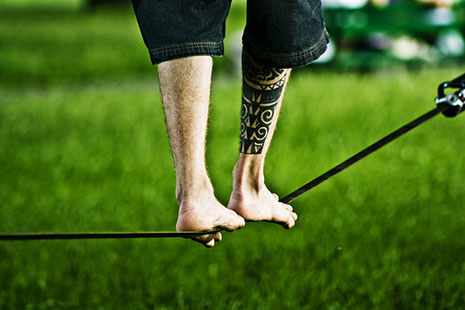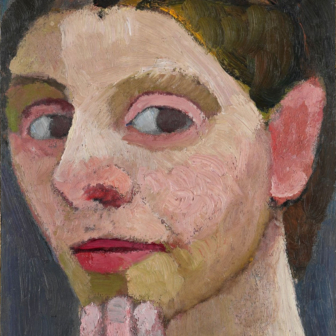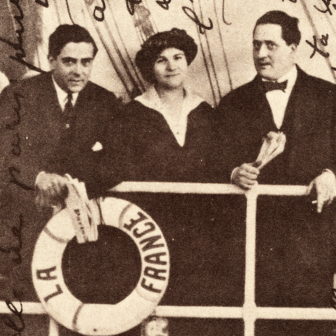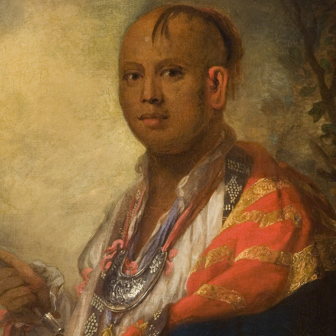MARCH is Art Month in Sydney, which this year comprises over 200 exhibitions and events intended to “celebrate the vibrancy and diversity of contemporary art in Sydney.” In line with recent trends, Art Month focuses not only on art and artists but also on the roles of curators and collectors, and on the relationships between art and such cognate fields as design, fashion and film. Meanwhile, in what could be mistaken for a parallel universe, Sydney has just hosted, on 7–9 March, the sixth Australian Tattoo and Body Art Expo, in which local and international tattoo artists showed what they could do, often on the skin of willing canvasses.
Much can be made, and sometimes is, of the category of artists who have a foot in both of these universes, the fine art one and the tattoo one. But in reality it is a very small group indeed. There are occasional examples, like the New York artist Scott Campbell, of tattooists who have crossed over successfully into non-skin art, and many more instances of tattooists who began at art school or trained in illustration and design before embarking on what is still essentially an apprenticeship. Of the many who cross over in this way, few return.
Some might argue that the “artist” bit of “tattoo artist” is a misnomer, a piece of professional credentialism that obscures the fact that tattoo designs, far from being original, are typically repetitive, derivative and uninventive. The same kinds of motifs – mythical, botanical, anatomical – recur and recur, filling folders with templates for the consideration of the prospective client. And yet there is much in the tattoo world that the art world can legitimately envy: the strength of the relationship between artist and client, the willingness of the client to stick with the artist in building up a portfolio, the sense of an art-loving community that crosses boundaries of gender and class, and the knowledge on the part of the artist that the work will remain on display – or potential display, depending on how rugged-up the “canvas” is at any given time – for many decades to come. Tattoos literally unite the work with the owner. And for the viewer, the reaction to the work is mixed up with the reaction to the personality of the canvas. Most importantly of all, tattoos are moving pictures, in an age that values movement over stillness. Unlike paintings that hang on a wall, tattoos get about, constantly changing location, constantly acquiring new viewers.
More and more people are getting themselves tattooed, but not all tattoo owners are happy with their choices. In 2011, the actor Mark Wahlberg began the long and painful process of having his tattoos removed. Among the images acquired in his youth were a misaligned shamrock on his ankle, which he first tried to deal with by having it inked over with Tweety Bird, and one of Bob Marley on his upper arm. Years later, and as the father of four children, Wahlberg felt that the tattoos spoke too loudly of a less responsible past. “I’ve taken my two older kids to the procedure so they see how painful it is and what I have to go through,” he said. “It’s like getting burned with hot bacon grease… Hopefully that will deter them.” By means of erasure – an expensive and painful process involving repeated laser treatments or in drastic cases surgery – or else by means of so-called cover-up tattoos, the supposedly indelible past is consigned where it belongs, to the past.
Yet tattoos don’t necessarily speak of irresponsibility or of a past that belongs in the past. The Sydney Morning Herald recently carried an eye-catching and in its way inspiring report of another father, Tony Hilton, who has been working as a bricklayer on the new building designed by Frank Gehry for the University of Technology, Sydney. Hilton regards the opportunity to help realise Gehry’s daring and complex vision as the best thing that has happened in his working life so far, and to celebrate he has had his arm and shoulder tattooed with one of the several unusual bricklaying patterns that are being deployed on the structure. The names of his wife and three daughters have been incorporated into the design, explicitly linking the two most important parts of his life, his family and his work.
Meanwhile, the NSW Police Service is banning neck tattoos – or “job-stoppers” – on new recruits, although exceptions can be made for those already employed. The Body Art and Modification Policy, approved in late 2013, proscribes “any form of body art or modification that is on the face, neck, ears, scalp or hands.” It comes down to a question of community relations. “Some of the older generation don’t like tattoos,” explained assistant commissioner Carlene York when the policy was announced, navigating her way with PR professionalism through a cultural minefield. “They feel a bit scared.” And yet, as York allows, not all older people are worried by tattoos. They might be tattooed themselves, or quite like the idea of getting one done, preferably on a part of the body less likely to be showing the adverse effects of age, given that skin, like canvas, bulges and sags over time. The veteran British broadcaster David Dimbleby, aged seventy-five, was photographed recently having a tattoo – of a scorpion – inked onto his right shoulder. It was something, he commented at the time, that he had “always wanted to do.”
The aura of permanence surrounding tattoos affects people differently – what puts one person off is the very thing that attracts another. For the cautious, an awareness of how you might feel in the future, as opposed to how you feel now, will seem to be a useful attribute, preventing all kinds of “mistakes.” On the other hand, you can think too much about that sort of thing. What prospective bride or groom wants to be told, for example, by a Jeremiah masquerading as a friend, that X per cent (insert a very high number here) of marriages end in divorce within Y years (insert a very low number)? In the same way, who wants to be told that you and Lisa or Ben, whose name you are planning to have tattooed on your arm or your leg or your lower back, may no longer be an item next month, never mind in ten or twenty years? A tattoo sends a message to your older self, a reminder of something important that should not be forgotten. It’s an expression of faith in the present, defying the future and daring it to do its worst.
ON THE FACE of it, the continuing popularity of tattoos is something of a paradox. We generally think of anything fashionable as having a use-by date built into it – the whole point of fashion being that it changes. A designer jacket remains in vogue for a season, maybe two, and after that, if put away and kept in reasonable condition, it will qualify one day as retro-fashion. In the meantime it will be defined not as retro (good), but as yesterday (bad). Yet tattoos, which have never, despite what the naysayers say, been more popular, cannot be so easily put aside. They can be disguised – a sleeve tattoo by a shirt-sleeve, for instance – but they are still lurking there, underneath, a fashion that never dies. Even when the tattoo is removed or over-stamped, traces remain.
Commentary on the fashion for tattooing, whether for or against, will often focus on the state of mind of the people getting tattooed. They may think about it for ages – will I, won’t I? – but when they finally make the decision it must have been because they were drunk at the time, or under the malign influence of something or someone, or in some way or other not their true, autonomous selves. They just weren’t thinking clearly. Or, runs the counter-proposition, they were living “in the moment,” as the confident, unworried, spontaneous self they would like always to be. The tattoo will go on reminding them of that freer version of themselves, whatever other embarrassments it might call to mind.
And as for the embarrassments of the past, who cares? They’re moments in time, and moments in time have their own validity. The advantage of a tattoo is that, unlike those ever-accumulating images on phones and Facebook, images that can soon spin out of the individual’s control, a tattoo is personal in the most literal sense. People will often comment on the way that a tattoo represents a stage of their lives, its emotional significance fully apparent only to the wearer of the tattoo. “My body is like a scrapbook,” says one interviewee in a recent Guardian feature on the growing number of women with tattoos. “Tattoos are markers on my body,” says another, “ to show how I was feeling at the time. They don’t have to have huge symbolism.”
In the digital world, we can keep on posting images and observations – markers of “how I was feeling at the time” – for as often and as long as we wish. There are no limits. By contrast, each of us has only so much skin. In the first episode of the first season of the UK series My Tattoo Addiction, one of the seemingly dozens of reality television programs that revolve around the tattoo culture, there is an unsettling encounter with a man who has, after going through a difficult divorce, fallen in love with Miley Cyrus. He has sixteen tattoos of Miley – her face or her name or the title of one of her songs or albums – when we meet him and is about to acquire his seventeenth. (He has since, apparently, acquired several more.) The tattoos make him happy, but he has two main fears, and both of them, we can’t help recognising, are founded securely in reality. One is that he will run out of space, and the other is that he or Miley will change, that she will no longer be the girl of his dreams. “I’m scared,” he confesses, “that this obsession might just leave me.” It is indeed a prospect to be dreaded. Instead of, for example, the name of a former girlfriend with Cupid’s arrow through it – a relatively minor embarrassment – he will be lumbered, forever and a day, with seventeen more or less indelible reminders on his skin of the woman he no longer loves.
As any collector will testify, it is hard to stop once you get started. One of the recurring motifs of what might be called tattoo literature – the abundant supply of commentary and reflection on what the tattooing fashion is really all about – is the observation that one tattoo is never going to be enough. “It’s all about coverage,” says the American fashion and style guru, and keen acquirer of tattoos, Nick Wooster, thereby downplaying the aesthetic role of the tattoo-ee. Leave that to the experts, he more or less says. Even if the tattoo artist – the expert – is not in fact particularly expert, the finished work will still say something about you, because it’s the coverage, the entire display, the story, that counts. Tattooists are artists, and artists have certain privileges, including the privilege of determining what in the end the finished work will look like. Just as the portraitist traditionally does not allow the sitter to see the painting until it is finished, so the tattoo artist is typically able to hold off until the big reveal. (The practical realities of tattooing help here – it’s hard, even with mirrors or display screens, to keep track of what someone is inking onto your back.)
All this suggests that, in a very traditional sense, the real power remains with the creator, whose vision is being realised on the canvas. But just as the supremacy of the artist is increasingly challenged in the art world, so it is in the world of tattooing. Patrons, collectors and curators are the new pretenders to the creative laurels in fine art, and the same holds true for the world of tattoos. What is more, the patron who commissions a tattoo holds a couple of extra cards that the art curator or collector doesn’t – he or she is also the canvas, and the exhibition space as well. The canvas, moreover, is quite capable of talking back. In another example of tattoo television, Ink Master, the success of the various tattooists, competing against one another to produce the most successful design, is judged not only by a team of experienced tattooists but also by a “canvas jury” – a case of the medium quite literally sending the message.
The web abounds with examples of tattoo disasters – the phrase or character in a foreign language, for example, that turns out to mean something quite different from what you thought it meant – but this has done little to slow the rate of increase. Celebrities celebrate – an occasion, a milestone – by getting tattooed together, as do classmates and teammates and family members. The story of the celebrity’s tattoo, how it was acquired and why, is an item of general interest. Spelled out step by step on Twitter, it forms a genre in itself, a tale for the times. Where celebrities lead, others follow, to the point where, for some time now, not getting a tattoo has required decisiveness rather than inertia. To remain a cleanskin is no longer the clear default position it once was. “See the amazing untattooed man,” exhorts a fairground sign in a cartoon by Michael Heath, recently reproduced in Private Eye: A Cartoon History (2013).
THE RISE of the tattoo as a lifestyle statement is explored in the second number of the new, lively and London-based photography journal The Quarterly, which features articles, and numerous images, devoted to the practice of tattooing as both art and fashion, and to the way tattoos now sit somewhere on the boundary between edgy and mainstream. Among the interviewees – and photographic subjects – is the comprehensively-inked Billy Huxley, who has, in a short space of time, gone from unemployed roofer to highly successful model, something that would have been unlikely even just a few years ago.
Huxley is keen to counter the idea that tattooing is all about consciously getting what everyone else has (a skull, a dragon), even though you might well end up doing just that without even knowing it at the time. He’s dismissive, too, of the idea of getting a tattoo just “to look cool.” It’s all about your tattoos in toto, about building a collection that works as a whole. It’s about curating your own individuality, creating over time your life story on your skin. (He is rather disdainful of an unnamed fellow model who has embarked on an accelerated inking strategy, all the better to capitalise on the trend for tattooed models – it’s just all too deliberate and fake.)
For Huxley, the meaning of his own body art lies in the way the images have been accumulated, and in what they uniquely say about him. “A girl once told me,” he says, that “having roses tattooed on your body means you’re a prostitute. I’ve got twenty-four roses tattooed on me, but it’s not like I charge for sex.” The subject defines the art, and not the other way around. Nor does Huxley see his tattoos as limiting his career prospects, for the very good reason that the career he is currently engaged in – modelling – already has a pretty inflexible age limit on it. The tattoos won’t make much difference to his professional end-date, about which he is philosophical. Which raises yet another paradox. The permanence of the tattoo (whether it’s under your clothes or on your face or hands) offers to separate you from the permanent – for “permanent,” read endless and dreary – side of life, from the dullness of being a time-server, in thrall to the organisation. “People call them job killers,” says Huxley in another interview, referring to his hand tattoos. “I call them office killers.”
But for how long will tattoos remain office killers? Tattooing has embraced age and class and gender to the point where no one – no grown-up anyway – can now be considered ineligible for canvas-hood. As Deborah Hill points out in the introduction to her photographic anthology Body Art, published recently by the National Library of Australia, the attraction of tattoos is that they take self-expression to an irreversible extreme. You put your money where your tattoo is, or something like that. But it won’t always be that way. Though the time has not quite arrived yet, it seems certain that one day soon tattoo technology will provide us with images that, while convincingly mimicking the real thing, will also be easily erasable or changeable, or will slowly fade away to nothing, leaving space for something that more accurately reflects the new you. The element of risk and daring, a gamble on the future, will be lost. But then again, perhaps it is already being lost. As tattoos are progressively mainstreamed – no longer the province of particular social groups but open to everyone – the element of risk declines. It is harder to be edgy when everyone else is edgy too. •




